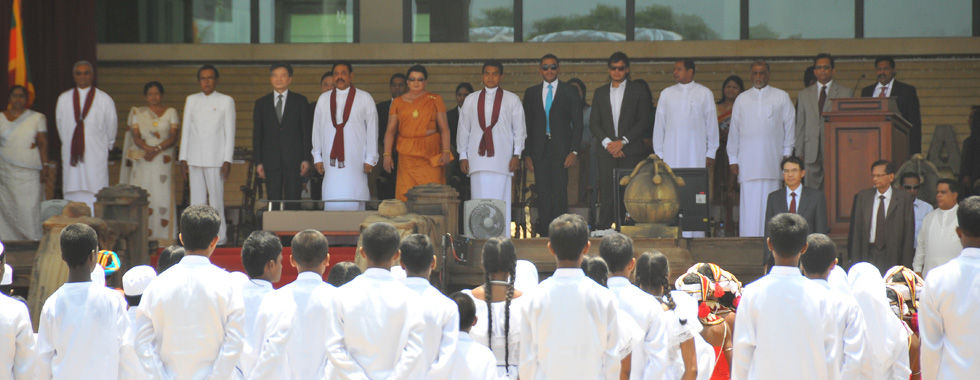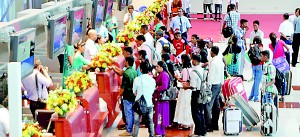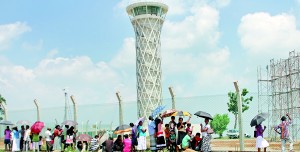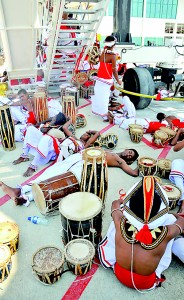News
MRIA opens in the middle of nowhere to empty skies
View(s):A day out at Mattala, in sweltering heat, to witness the unveiling of a new airport. Namini Wijedasa reports from the site
Chinese and Sri Lankan flags fluttered side by side at the opening of Sri Lanka’s second international airport last week.
“China and Sri Lanka were traditional partners and good friends,” enthused Luo Fuhe, envoy of Chinese President Xi Jinping, punctuating each sentence with a benevolent smile. They were “brothers in one boat” and this relationship will endure well into the future.

Students and traditional drummers welcome the President and other VIPs
In the distance, the gleaming new control tower rose from the parched earth— a beacon to the four flights that landed at Mattala Rajapaksa International Airport that day (MRIA). The first of these, a SriLankan Airlines A340, had brought President Mahinda Rajapaksa and his entourage to the venue.
The airport is a swanky edifice. Its light marble floors contrast pleasingly with its dark wooden ceiling. There are plush red chairs in the seating area. The wall behind the check-in counters is painted with a bold, contemporary design. The buildings encircle a modern, landscaped garden with palms and a refreshing water feature. This lends it the air of an oasis in the desert.
The terminal even has piers with aerobridges, a facility that Katunayake International Airport only acquired in 2005. With a runway long enough for the world’s largest passenger aircraft to land on, MRIA—despite its outlying location—is well equipped.
The official ceremony lasted several hours because, sources said, the “speeches were much longer than expected”. Most spectators had arrived early in the morning. As mildness gave way to a sweltering heat, VIPs in their suits and saris shifted uneasily in their seats. Their discomfort was worsened by the fact that their 500ml bottles of water soon ran out.

The plush inside of the new airport
None were as parched, however, as the thousands of ordinary people who had flocked to the event of their own volition. “Do you have water?” beseeched a perspiring woman, pressing against railings separating the public from the invitees.
“Miss, can’t you pass me a chair, I have a headache,” implored another, as she squinted with pain. In the stalls set up for invitees, rows of chairs sat empty. They would fill up only later.
“At least see if you can get us one pass,” said Randima, a 10-year-old with flushed cheeks. He wanted to sit with the VIPs, where it was shady.

Villagers stand in the hot sun while many were the empty chairs in shady spots. Pix by Indika Handuwala
“Apey chanda oney wenakota, api hondai langin thiyagannawa,” fumed his mother, W. Sriyani. “Methana mechchara putu thiyenawa. Ei apita wenaskan karanney?” (“When they want our votes, we are good enough for them to keep us close. There are so many chairs here. Why are we being treated differently?”).
These spectators were from small towns and villages in and around Hambantota district. Some came in vehicles arranged for them by local politicians, while a vast majority came at their own expense in their own transport- Canters, hand tractors, vans and minibuses.
Public buses were also commissioned to cater to the large crowds. Eight luxury buses were deployed on the Southern Expressway, to ferry people from Colombo. However, one driver said that he had collected only Rs 1,600 from the trip to Mattala, as most passengers had boarded after Matara. An international airport was only a dream for people in this part of the country,” said Dhammika Edirisinghe, who hired a van with 18 others from Embilipitiya. “I came here even five days ago, and went inside the airport,” she said. “It was beautiful.”
Rohana Nanayakkara, a 46-year-old former security guard, took a private bus from Galle with a friend. They were brimming with excitement. “It’s the first time since independence that an international airport was opened here in Sri Lanka,” he said. “We need a second international airport, and we support the President in this.”
Mr. Nanayakkara was not worried about the heavy loans taken to build the airport or, for that matter, anything else. “We need loans to develop the country,” he explained, much like President Rajapaksa did in his speech later on. “We will be able to pay these back in a few years, when we are financially stronger.”
Jinadasa, a 60-year-old chena cultivator from Godakawela, couldn’t think that far. It was too hot. “We came to see the airport, but it’s on the other side, and we are here,” he said. “Do you think they will let us in after the function is over? Maybe they can send us inside in a queue.”

Dead beat: Traditional drummers find a cool spot away from the heat
Like Mrs. Sriyani, he had been standing at the venue since 7 am. Even three hours later, at 10 am, there was not an aircraft in sight. (The first flight, with the President on board, landed 55 minutes later). They didn’t know how long the event would last. They were stationed the furthest away from the new terminal which was obscured behind the large, main stage. The sun beat down relentlessly.
Men, women and children gazed yearningly at the emptying bottles of water in the hands of some invitees. Mothers carried babies as young as a few months old. Their multi-hued parasols afforded little protection. As time passed, and the temperature rose even higher, children started crying.
A large group of students waited in the open space below the stage till the President finished his walkabout. Dressed in blinding white, they were to sing traditional verses of blessing. The ground was searing hot. Two of them, on the verge of fainting, were escorted out. Since there was no water for them to drink, journalists shared the little that was left in their bottles.
The ordinary public had varied reasons for being there. Chief amongst them was to visit the airport. Others wanted to see the president, watch the ceremony, or to catch sight of flights landing and taking off.
There were cheers and applause when a presenter announced the landing of the President’s plane. “Where is he coming from?” one guest asked her husband. “Japan,” he said, without missing a beat. The President had, in fact, boarded the symbolic flight from Katunayake International Airport.
The President’s address was the last of several speeches. He said his government had invested much revenue on infrastructure projects. “But we took international loans to finish them,” he nodded. “We did not hesitate, and will not hesitate to do so. I think this is something other countries in the world do, even powerful countries. You have to take loans to develop a country. We will pay them back.”
The President also referred, rather aptly, to the climate. “I believe that a man who can tolerate this scorching climate, can tolerate any climate or challenge,” he said. Nevertheless, many of those who had stood unprotected in the sun for hours, were gone by then.
After the function, official guests swarmed into the airport. Many headed towards water dispensers. The Rajapaksa sons- Namal, Yoshitha and Rohitha, obligingly posed for photographs. So did songsters Bhathiya and Santhush, who had belted out the theme song. Out on the tarmac, Druvi Perera, captain of the President’s flight, took snaps with his cockpit crew. It was a historic moment, after all.
Namal, who was dressed identical to his father, gave interviews to the international media. “It’s very hot isn’t it?” he asked one journalist. “But I’m used to this.”
Follow @timesonlinelk
comments powered by Disqus


















